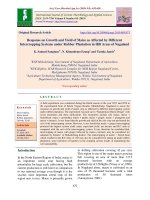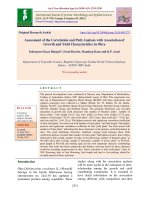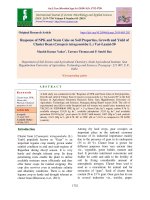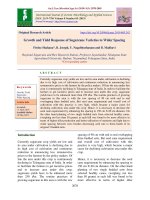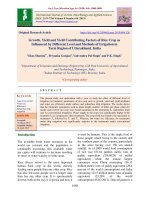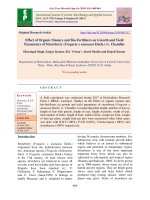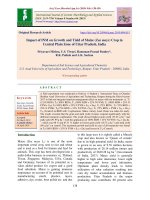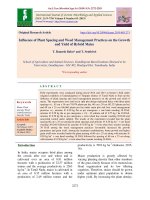Gamma radiation effects seed germination, plant growth and yield attributing characters of fennel (Foeniculum vulgare Mill.)
Bạn đang xem bản rút gọn của tài liệu. Xem và tải ngay bản đầy đủ của tài liệu tại đây (204.65 KB, 11 trang )
Int.J.Curr.Microbiol.App.Sci (2017) 6(5): 2448-2458
International Journal of Current Microbiology and Applied Sciences
ISSN: 2319-7706 Volume 6 Number 5 (2017) pp. 2448-2458
Journal homepage:
Original Research Article
/>
Gamma Radiation Effects Seed Germination, Plant Growth and Yield
Attributing Characters of Fennel (Foeniculum vulgare Mill.)
Arvind Kumar Verma1*, Sitaram Sharma2, Rajesh Kumar Kakani1,
Ram Dayal Meena1 and Sharda Choudhary1
1
2
ICAR- National Research Centre on Seed Spices, Ajmer-305206, Rajasthan, India
Department of Horticulture, MJRP College of Agriculture, MJRP University, Jaipur - 302019,
Rajasthan, India
*Corresponding author
ABSTRACT
Keywords
Foeniculum
vulgare, Ionizing
radiation, Mutants,
Plant growth,
Seed germination
Article Info
Accepted:
25 April 2017
Available Online:
10 May 2017
Narrow genetic base is the main problem hindering the conventional breeding in
fennel. Hence, an experiment was planned using the dried seeds of fennel
irradiated with different doses (15kR, 17.5kR, 20kR, 22.5kR and 25kR) of gamma
rays. The number of primary branches on harvesting was showed significant
difference as compared to control. In case of the number of secondary branches on
harvesting the difference was non-significant. The control plants showed earlier
(87.6 days) flowering compared to the gamma rays treated plants. In the same
way, earlier maturity was recorded in control (143.6 days) followed by 15kR
(144.2 days), 17.5kR (145 days), 20kR (147 days), 22.5kR (148.4 days) and 25kR
(150.4 days). Significant difference was observed with regards to number of
umbels per plant, number of umbellate per umbel, number of seeds per umbellate,
number of seeds per umbel, 1000 seed weight (g) and seed yield per plant (g).
Introduction
Fennel (Foeniculum vulgare Mill) is an
annual, aromatic herb having yellow flowers
and native of Southern Europe and Asia
(Khan and Musharaf, 2014). It grows erect to
a height of 2- 2.5 m and have hollow stem.
The leaves of plant grow around 40 cm long
and they are finely dissected with the ultimate
segments filiform, about 0.5 mm wide. The
flowers are arises in terminal compound
umbels. The fruit is 4-10 mm long, dry seed,
half as wide or less and groove. Mature fruit
commonly known as seeds and have essential
oil. It is also used as flavoring agents in food
products such as liqueurs, bread, cheese and
pharmaceutical
and
nutraceutical.
Traditionally fennel is used as antispasmodic,
diuretic,
anti-inflammatory,
analgesic,
secretomotor, secretolytic, galactagogue, eye
lotion and antioxidant cure (Lucinewton et
al., 2005). Besides this, fennel infusions are
the traditional decoction for treatment to
prevent flatulence and colic spasms (MimicaDuki´c et al., 2003). In India, the total area
under fennel is about 46760 ha, production
78570 tons and productivity is about 16.8 q/h
(Spice Board India, 2015–16). It is cultivated
throughout India at all altitudes up to 6,000 ft.
Gujarat and Rajasthan are the main fennel
2448
Int.J.Curr.Microbiol.App.Sci (2017) 6(5): 2448-2458
growing states in India. It is grown in small
scale in other states like Karnataka,
Maharashtra, Uttar Pradesh, Punjab, Bihar,
MP, Haryana and Jammu & Kashmir.
Although fennel cultivated worldwide, it
requires a fairly mild climate and is cultivated
as a cold weather crop in parts of North India.
A dry and cold weather is conducive for
better seed production. The potential yield of
fennel is still low and there is an urgent need
to increase the productivity. It is long duration
crop and requires 6-7 months for maturity.
Due to long duration crop farmers need to
give more inputs to produce the crop. The
normal plants height also high, hence, it
creates the chances of lodging and ultimately
it reduces the yield and quality of produce.
The Ramularia blight and gummosis are
another severe problems cause yield and
quality loss (Malhotra, 2016).
The improvement of fennel crop was made
mostly through conventional breeding method
(selection). Low genetic variability, tiny
flower size obstruct the artificial pollination
and incompatibility due to protandrous, which
promotes the cross pollination are the main
drawback of conventional breeding methods
in fennel (Bertin, 1993). Hence, for the
improvement in any characters of the plants
the most important requirement is to available
variability in the gene pool. The variability
may be available in natural population or it
may be created by the methods of
hybridization or mutation. Diminutive efforts
have been made to improve fennel crop
through genetic manipulation. Since, the
variability naturally present in most of the
seed spice crops including fennel is very low,
so, induced mutation can be an option for
improvement of this crop. Induced mutation
has been widely used in a number of crops
and species to generate broad spectrum of
genetic variability. Mutation breeding is
generally employed when low genetic
variability present in a gene pool for
particular trait (Fehr, 1993; Verma et al.,
2017). Physical and chemical mutagens
induce
physiological
damages,
point
mutations and chromosomal aberrations in M1
generation. Mutation induction with physical
mutagens was the most frequently used
method to develop mutant varieties (89%).
The use of chemical mutagens was relatively
infrequent. Gamma rays were employed to
developed 64% of the radiation induced
mutant varieties, followed by 22% by X-rays
(IAEA, 2015) gamma rays is an energetic
form of electromagnetic radiations are
recognized as the widely used mutagen for
their simple application, good penetration,
reproducibility and high mutation frequency
(Chahal and Gosal, 2002) gamma rays having
short wavelength with high penetrable power,
interact with atoms or molecules to produce
free radicals in the cells. Among the physical
mutagens, gamma ray stands first in its
effectiveness in the induction of mutation in
crop plants (Jan et al., 2011; Verma et al.,
2012).
Seed germination, plant survival, seedling
growth, pollen sterility and chromosomal
aberration are the normally used criteria for
studying physical mutagens sensitivity in
plants (Lal et al., 2009; Sangle et al., 2011).
The usefulness of a mutagen in mutation
breeding depends not only on its mutagenic
effectiveness, but also on its mutagenic
efficiency. The selection of effective and
efficient mutagen(s) is very crucial to recover
a high frequency and spectrum of desirable
mutations in induced mutation (Solanki and
Sharma, 1994). The mutagenic effectiveness
decreased with the increase in dose of
mutagen indicative of negative relationship
between them (Ganapathy et al., 2008;
Ramya et al., 2013). Mutations are mostly
recessive and they cannot be selected until the
second generation, whereas dominant
mutations occur at very low frequencies and
can be selected in the first generation.
2449
Int.J.Curr.Microbiol.App.Sci (2017) 6(5): 2448-2458
Although mutations are beneficial for
producing variability in populations, the
treatments themselves can be detrimental and
can cause a reduction in germination, growth
rate, plant viguor and pollen & ovule fertility
in a plant (Micke and Donini, 1993). Due to
induced mutation, if we could get short
stature and short duration plant with good
yield, we can save the inputs required for
producing crop, reduced the lodging problem,
reduces the chances of crop damage by
uncertain rain hailstorm etc. and farmers can
take more crops on the same piece of land.
The information generated will be useful for
mutation breeding in fennel crop by using
gamma ray.
branches / plant, days to flowering, days to
maturity/harvesting, numbers of umbels /
plant, numbers of umbellate / umbel, number
of seeds / umbellate, number of seeds per
umbel, test weight (g), seed yield / plant (g)
were recorded. All the data were analyzed
using the statistical software SPSS 16.0
(SPSS Inc., Chicago, IL, USA). The means
were separated by Duncan Multiple Range
Test (DMRT) at 5% level of significance. The
graphs were prepared by using Microsoft
Office Excel.
Results and Discussion
Materials and Methods
Effect of irradiation doses on seed
germination, seedlings survival and plant
growth
The experiment was laid out at ICARNational Research Centre on Seed Spices,
Ajmer, Rajasthan, during Rabi season of
2014-2015. The centre lies on 740 35’ 39” to
740 36’ 01” E longitude and 260 22’ 12” to
260 22’ 31” N latitude at an altitude of 460.17
m above mean sea level. The climate of this
zone is typically semi-arid and sub-tropical
characterized by mild winter, moderate
summers and associated with relatively high
humidity during the month of JulySeptember. The mean annual rainfall is 590
mm, mostly received from South-West
monsoon during the last week of June to
October. The dried seeds of fennel cv. RF-125
were used for irradiation. Seeds were exposed
to different doses of gamma rays (15kR,
17.5kR, 20kR, 22.5kR and 25kR) in gamma
chamber containing CO60as a source at
Bhabha Atomic Research Centre (BARC),
Mumbai. The dose rate of irradiation was 3.06
K kR/h. The observation on seed germination,
per cent survival number of leaves, total
numbers of roots per, shoot length/plant
height (cm), fresh weight of the plant (g), dry
weight of the plant (g), number of primary
branches / plant, number of secondary
The immediate effects of gamma rays
treatments were recorded in terms of
reduction in seed germination and seedling
survival in M1 generation. Perusal of data
presented in Table 1 shows that the increase
in dose of gamma rays, decreases the seed
germination as well as survival of seedlings in
fennel. Seed germination was 100% in control
and among the different doses of gamma rays,
the maximum seed germination was observed
at lowest dose 15kR (72.67%) followed by
17.5kR (69.67%), 20kR (68.33%), 22.5kR
(66.00%) and 25kR (51.67%) which was
statically significant differed from control.
The observations of seedlings survival clearly
showed that the increased doses of gamma
rays having lethal effect on seedlings survival.
The gamma rays dose of 25kR showed
51.67% seeds germination and 28.00%
seedlings survival as compared to control,
while 20kR recorded 68.33% seed
germination and 49.33% survival of
seedlings. Therefore, it is concluded that the
optimum dose for germination and survival of
fennel is 20kR and this dose statistically
different from other doses with regards to
reduction in seed germination and seedlings
2450
Int.J.Curr.Microbiol.App.Sci (2017) 6(5): 2448-2458
survival. The results indicated that the
decreased in the seedling height in all doses
of gamma rays may be due to increase in
seedling injury. The gamma rays had a highly
significant impact on reduction in number of
leaves, number of roots, root length, shoot
length and fresh weight per plant. The number
of leaves per plant (15.4), number of roots (9),
root length (6.66), shoot length (6.24 cm) and
fresh weight per plant (0.0491g) was recorded
at the dose of 20kR. The number of leaves per
plant, number of roots per plant and root
length was at par with 17.5kR dose of gamma
rays. The growth parameters were dose
dependent, as the dose of gamma rays
increased from 15kR to 25kR there was
gradual decrease in number of leaves, number
of roots per plant, root length, shoots length
and fresh weight per plant and increase in
seedling injury were recorded. Among the
different doses of gamma rays, the maximum
number of leaves (20.8), number of roots per
plant (17.2), root length (16.94 cm), shoots
length (12.86 cm) and fresh weight per plant
(0.0904 g) was observed at lowest dose of
gamma rays (15kR) followed by 175kR,
20kR, 22.5kR and 25kR. It was recorded that
about 50% seedling survivability and 50%
reduction in vegetative growth parameters at
20kR of gamma rays.
The results presented in Fig. 1 regarding to
plant height at different growth stages. The
growth of plants significantly reduced in
gamma rays irradiated plants when compared
the control. The shoot length in 15kR
irradiated plants was 11.82 cm while in
control plants were 14.66 cm and it reduced
with the increase in the dose of gamma rays
after 40 DAS. It indicates that the increase in
dose of gamma rays increases the damage of
seedlings. The height of plants significantly
reduced in irradiated plants as compared to
the control. The plants height at 60 DAS was
38 cm in control where as reduced to 36.2 cm
in 15kR irradiated plants followed by 17.5kR
(34.1 cm), 20kR (32.4 cm), 22.5kR (31.8 cm)
and 25kR (29.8 cm). The Plant height on
harvesting was 140 cm in control followed by
15kR (136.4 cm), 17.5kR (133.2 cm), 20kR
(123.2 cm), 22.5kR (122.4 cm) and 25kR
(121.4 cm). Growth and development in crop
did not proceed at constant or fixed rates
through time. Gamma irradiation of seeds has
been found to exert pronounced effects on
plant growth.
The growth of plants affected by exposure
with different doses of gamma rays, the result
evident from Table 2 shows that the number
of primary and secondary branches on 60
DAS reduced at 15kR (5.2), 17.5kR (6.2),
20kR (6), 22.5kR (6) as compared to control
(6.4). The primary branches at gamma rays
dose of 25kR were higher (6.8) but non
significant as compared to control. The
number of primary and secondary branches at
harvesting time in some gamma rays dose was
decreased and in some dose was increased as
compared to control (Table 2). Gamma ray
doses 15kR (9.4), 17.5kR (12.2), 20kR (13.8)
and 22.5kR (14) reduced the numbers of
primary branches as compared to control (14)
at the time of harvesting The irradiation dose
25kR shown higher (15.4) and significant
numbers of primary branches results. There
was an increase in the numbers of secondary
branches in all irradiated plants and maximum
number of secondary branches was observed
at 20kR (34) of gamma rays.
The relationship between dose of gamma rays
and germination percentage in fennel was
inversely proportional. As the dose of gamma
rays was increased the germination and
survival rate decreased. In a study the
germination percentage and percent survival
decreased
with
an
increase
in
dose/concentration of the mutagens in
fenugreek (Bashir et al., 2013). They
concluded that lower treatments of mutagens
have influenced less biological damage and
2451
Int.J.Curr.Microbiol.App.Sci (2017) 6(5): 2448-2458
would be suitable for inducing desirable
mutations. Similar findings were reported
where in higher doses of gamma radiation
reduced germination percentage and survival
in Moluccella laevis (Minisi et al., 2013). The
reduction in germination and survival may be
due to absorption of ionizing radiation in
biological materials, acting directly on critical
targets in the cell (Kovacs and Keresztes,
2002). Some of the seedlings were germinated
but they died in further growth due to the
injury caused by gamma rays. In this study, it
was found that mutagenic treatment severely
affected germinability in M1 generation
confirming earlier mutation work done on
fenugreek using chemical mutagens (Basu et
al., 2008; Siddiqui et al., 2008). Higher doses
(˃ 5 kR) of gamma radiation had negative
effects in nigella (Maamoun et al., 2014).
However, the base populations differed in
their response to mutagenic treatment
confirming earlier work about use of multiple
adapted cultivars for crop improvement using
mutation breeding (Yadav and Krishna,
2013). Relationship between mutagenic dose
and germination percentage was inversely
proportional has been recorded in coriander
(Mahla et al., 1999) and asshwagandha
(Bhosale and More, 2014). These results were
in accordance with the earlier report wherein,
it was observed that the plantlet survival rate
kept decreasing with increasing irradiation
dosage for three weeks after irradiation in
Centella asiatica (Moghaddam et al., 2011).
The results obtained indicated that survival of
plants to maturity depends on the nature and
extent of chromosomal damage. Increasing
frequency of chromosomal damage with
increasing radiation dose may be responsible
for less germinability and reduction in plant
growth and survival (Kiong et al., 2008). The
inhibition of seed germination at high doses
could be due to the damage in seed tissue,
chromosomes and subsequent mitotic
retardation and the severity of the damage
depend on the doses used (Datta, 2009).
With regards to plant growth, increased in
gamma rays doses significantly decreased in
pant growth parameters. The high dose
irradiation that caused growth inhibition could
be ascribed to the cell cycle arrest during
somatic cell division and/or various damages
in the entire genome (Preussa and Britta,
2003). In another report the higher efficiency
of lower dose of gamma rays could be
described to the fact that biological damage
(seedling injury, lethality and sterility)
increased with increase in dose at faster rate
than the mutations. Inhibition effect by
gamma-irradiation may be related to auxin
and DNA biogenesis in a relationship which
showed that auxin required for the formation
of DNA and radiation block occurring in the
formation of auxin and nucleic acid synthesis
(Momiyama et al., 1999; Krasaechai and Yu,
2009). Growth and development in plants do
not advance at invariable rates through time.
Development of plant is a term that comprises
a broad spectrum of processes by which plant
structures originate and mature as growth
occurs. Any change in growth pattern will
ultimately affect maturity and yield. Gamma
irradiation of seed has been found to exert
pronounced effects on plant growth. The
exposure to gamma irradiations can have
stimulatory effects on some particular
morphological characters and can enhance the
yield of plants in terms of growth,
reproductive and ability to withstand water
shortage.
Effect of irradiation on flowering and
yields attributing characters
A glance of result presented in Table 3
revealed that the gamma rays significantly
affected the number of days required for
flowering and maturity. The gamma rays dose
delayed the flowering in irradiated plants than
control plants (87.6 days). Among the
irradiated plants, early flowering was
observed on 15kR (88.6 days), followed by
2452
Int.J.Curr.Microbiol.App.Sci (2017) 6(5): 2448-2458
17.5kR (89 days), 20kR (91.4 days), 22.5kR
(92.8 days) and 25kR (93.8 days). Significant
difference was observed in all doses of
gamma rays except for 15kR with regards for
delaying in flowering as compared to control.
This observation revealed that higher dose of
gamma rays has significant cause the delaying
of flowering. The number of days required for
maturity was increased with increase in the
dose of gamma rays. The lowest gamma rays
dose 15kR (144.2) took minimum days to
maturity among all irradiated dose. The
results with this regard revealed that the
maturity of fennel crop delayed by application
of gamma rays.
The data presented in Table 4 indicated that
the application of gamma rays had significant
effect on yield attributes related aspect as
compared to non irradiated plants. The
gamma irradiation doses have significant
effect on number of umbel per plant. The
number of umbel per plant was maximum on
the dose of 25kR (31.8), followed by 20kR
(30.8) and 17.5kR (29.6) and this results was
significance when compared to control (24.4).
The number of umbellate per umbel
significantly decreased in all doses of gamma
rays as compared to control. It can be infers
that gamma rays had negative effect on
number of umbellate per umbel. Nevertheless,
the pre-sowing treatment of gamma rays
resulted in increase the number of seeds per
umbellate on all doses of gamma rays
compared to control.
The maximum number of seeds per umbellate
was recorded at the gamma rays doses of
25kR (34.8) followed by 22.5kR (30.2),
20kKR (29.8), 15kR (29.4) and 17.5kR
(29.2). The maximum number of seeds per
umbel was recorded on gamma rays dose of
22.5kR (866), followed by 25kR (863.6),
17.5kR (836) 20kR (834.4), 15kR (743) and
control regarded the least (732.4). The 1000
seed weight was deceased in all irradiated
plants with different doses as compared to
control. The numbers of seeds per umbel were
more but test weight was lower due to small
seed formation in irradiated plants. The
maximum seed weight was observed in
control (732.4g) followed by 20kR (6.24g),
25kR (5.32g), 15kR (4.97g), 17.5kR (4.76g),
25.5kR (4.67g). The seed yield was increased
in the dose of 20kR (42.4g), 25kR (41.6g)
followed by 22.5kR (39g) and decreased in
175kR (32.4g) and 20kR (31g) as compared
to control (36.8g).
In induced mutation it was found that mutants
showed early flowering in coriander (Datta
and Sengupta, 2002). An experiment was
conducted by exposing the seeds to gamma
rays, ethyl methane sulphonate and sodium
aside in fenugreek. The study revealed that
pollen fertility decreased with an increase in
dose/concentration of the mutagens (Bashir et
al., 2016). Delayed in first flowering in
ashwagandha was reported by the irradiated
the seeds with different dose of gamma rays
(Bharathi et al., 2013). Our result was also
same as we also found delayed in flowering in
gamma rays irradiated plants. Increasing
concentration of both chemical mutagens led
to gradual reductions in the number of days to
flower by stimulating early initiation of
flower bud. However, higher concentration of
both chemical mutagens caused a delay in the
number of days to flower in soybean (Mensah
et al., 2013).
The increase in the quantitative and
qualitative characters of the crop is one of the
most
important
objectives
of
crop
improvement. Any change in growth pattern
was finally affected the maturity and yield.
The exposure to gamma irradiations has
stimulatory effects on specific morphological
parameters and can increase the plants in
terms of growth and yield. We found the
increase in yield attributes character of fennel
by the irradiation.
2453
Int.J.Curr.Microbiol.App.Sci (2017) 6(5): 2448-2458
Table.1 Effect of different doses of gamma irradiation on seed germination, seedlings survival
and plant growth at 30 DAS. Same superscript letters in a column do not differ significantly
when compared by DMRT test at 5% level of significance
Dose (kR)
Germination
percentage
(Relative)
Survival
percentage
Number
of leaves
No.
of
roots
Root
length
(cm)
Shoot
length/plant
height (cm)
0 (Control)
15
17.5
20
22.5
25
100.00a
72.67b
69.67bc
68.33c
66.00c
51.67d
100.00a
67.33b
54.00c
49.33d
43.67e
28.00f
20.8a
17.2b
15.4c
15.4c
14.2c
12.8d
17.2a
12.2b
10.0c
9.0cd
8.0de
6.6e
16.94a
9.02b
7.54c
6.66c
4.82d
3.86d
12.86a
8.76b
7.678c
6.24d
5.40e
3.92f
Fresh
weight
per plant
(gm)
0.0904a
0.0647b
0.0633b
0.0491c
0.0439d
0.0260e
Table.2 Effect of different doses of gamma irradiation on number of primary branches per plant
at 60 DAS and at harvesting and number of secondary branches per plant at harvesting. Same
superscript letters in a column do not differ significantly when compared by DMRT test at 5%
level of significance
Dose (kR)
0 (Control)
15
17.5
20
22.5
25
No. of primary
branches per plant
at 60 days
6.4a
5.2b
6.2a
6.0ab
6.0ab
6.8a
No. of primary
branches per plant at
harvesting time
14ab
9.4d
12.2c
13.8b
14.0ab
15.4a
No. of secondary
branches per plant at
harvesting time
31.0b
31.4b
32.8ab
34.0a
33.0ab
32.4ab
Table.3 Effect of different doses of gamma irradiation on number of days required for flowering
and number of days required for maturity. Same superscript letters in a column do not differ
significantly when compared by DMRT test at 5% level of significance
Number of days required for
flowering
Number of days required for
maturity
0 (Control)
15
87.6c
143.6c
88.6c
144.2c
17.5
89.0bc
145.0bc
20
91.4abc
147.0abc
22.5
92.8ab
148.4ab
25
93.8a
150.4a
Dose (kR)
2454
Int.J.Curr.Microbiol.App.Sci (2017) 6(5): 2448-2458
Table.4 Effect of different doses of gamma irradiation on number of umbel per plant, number of
umbellate per umbel, number of seeds per umbellate, number of seeds per umbel, 1000 seed
weight, test weight and seed yield per plant. Same superscript letters in a column do not differ
significantly when compared by DMRT test at 5% level of significance
Dose (kR)
Number of
umbel per
plant
Number of
umbellate per
umbel
Number of
seeds per
umbellate
Number of
seeds per
umbel
1000
seed
weight
(g)
Seed
yield per
plant (g)
0(Control)
24.4b
29.2a
29.2b
732.4b
6.33a
36.8a
15
24.2b
26.2b
29.4b
743.0b
4.97c
32.4c
17.5
29.6a
23.4c
29.2b
836.0a
4.76d
31.0c
20
30.8a
26.4ab
29.8b
834.4a
6.24a
42.4a
22.5
26.2b
28.2ab
30.2b
866.0a
4.67d
39.6b
25
31.8a
27.2ab
34.8a
863.6a
5.32b
41.0ab
Fig.1 Effect of different doses of gamma irradiation on plant growth
This result was supported by another
experiment in which a very high magnitude of
genetic coefficient of variability grain yield
per plant followed by number of pods per
plant and leaf area in black gram after gamma
rays irradiation (Lal et al., 2009). A pot
experiment conducted to study the effect of
gamma-rays degraded sodium alginate on the
performance of growth and yield of fennel.
They observed that foliar spray of radiation
degraded alginate improved the yield (umbels
per plant, umbellets per umbel, hundred seed
weight and seed yield) of fennel (Sarfaraz et
al., 2011). By using different doses of gamma
rays in fenugreek, two identified unique
mutant which different from the parent line
with respect to number of pods per plant and
seed yield per plant (Kakani et al., 2012). In
the same manner gamma rays induced
variation in coriander (Singh et al., 1992). 15
viable types mutants selected in the M2
generation of celery, fennel and ajowan after
treatments with gamma-rays and EMS.
Gamma irradiation was more potent in
inducing higher frequency of mutation than
EMS in celery and ajowan (Paul and Datta,
2005). Nigella seeds expose to gamma rays
increased the seed weight and seed number as
compared to the control plants (Kumar and
Gupta, 2007).
2455
Int.J.Curr.Microbiol.App.Sci (2017) 6(5): 2448-2458
Acknowledgement: The authors are thankful
to the Director, NRCSS, Ajmer for provide
necessary facility to carry out this experiment.
We also thank Bhabha Atomic Research
Centre, Mumbai for irradiation of seeds.
References
Bashir. S., Wani, A.A. and Nawchoo, I.A.
2013. Mutagenic sensitivity of gamma
rays, EMS and sodium azide in
Trigonella foenum-graecum L. Sci. Res.
Reporter, 3: 20–26.
Basu, S.K., Acharya, S.N. and Thomas, J.E.
2008.
Genetic
improvement
of
fenugreek (Trigonella foenum-graecum
L.) through EMS induced mutation
breeding for higher seed yield under
western Canada prairie conditions.
Euphytica, 160: 249–258.
Bertin, R.I. 1993. Incidence of monoecy and
dichogamy in relation to selffertilization in angiosperm. American J.
Bot., 80: 557–560.
Bharathi, T., Gnanamurthy, S., Dhanavel, D.,
Murugan, S. and Ariraman, M. 2013.
Induced Physical mutagenesis on seed
germination,
lethal
dosage
and
morphological mutants of ashwagandha
(Withania somnifera (L.) Dunal). Int. J.
Adv. Res., 1: 136–141.
Bhosale, R.S. and More, A.D. 2014. Effect of
gamma radiation on seed germination,
seedling height and seedling injury in
Withania somnifera, (L.) Dunal. Int. J.
Life Sci., 2: 226–228.
Chahal, G.S. and Gosal, S.S. 2002. Principles
and Procedures of Plant Breeding.
Oxford: Alpha Science International
Ltd. 399–412.
Datta, A.K. and Sengupta, K. 2002. Induced
viable macromutants in coriander
(Coriandrum sativum L.). Indian J.
Genetics and Plant Breeding, 62: 273–
274.
Datta, S.K. 2009. A report on 36 years of
practical work on crop improvement
through induce mutagenesis. In:
induced plant mutations in the genomics
Fra, Shu, Q.Y. (Fd). Food and
Agriculture Organization of the United
Nations, Rome, 253-256.
Fehr, W.R. 1993. Principles of Cultivar
Development: Theory and Technique.
Vol.
II.
Macmillan
Publishing
Company, USA.
Ganapathy, S., Nirmalakumari, A., Senthil,
N., Souframanien, J. and Raveendran,
T.S. 2008. Isolation of macromutations
and mutagenic effectiveness and
efficiency in little millet varieties.
World J. Agri. Sci., 4: 483–486.
International Atomic Energy Agency (IAEA)
2015.
Mutant
variety
database.
Jan, S., Parween, T. and Siddiqi, T.O. 2011.
Mahmooduzzafar. Effect of gamma
radiation
on
morphological,
biochemical, and physiological aspects
of plants and plant products. Environ.
Reviews, 20: 17–39.
Kakani, R.K., Saxena, S.N., Meena, S.S.,
Sharma, Y.K., Meena, R.S. and Kant,
K. 2012. Two unique induced mutants
identified in fenugreek for growth habit
and leaf characteristics. Int. J. Seed
Spices, 2: 66–68.
Khan, M. and Musharaf, S. 2014. Foeniculum
vulgare Mill. A Medicinal Herb.
Medicinal Plant Res., 4: 46–54.
Kiong, A., Ling Pick, A., Grace Lai, S.H. and
Harun, A.R. 2008. Physiological
responses
of
Orthosiphon
stamineusplantlets
to
gamma
irradiation.
American-Eurasian
J.
Sustainable Agri., 2: 135–149.
Kovacs, E. and Keresztes, A. 2002. Effect of
gamma and UV-B/C radiation on plant
cell. Micron, 33: 199–210.
Krasaechai, A. and Yu, L.D. 2009. Lowenergy ion beam modification of
horticultural plants for induction of
2456
Int.J.Curr.Microbiol.App.Sci (2017) 6(5): 2448-2458
mutation. Surface and Coatings
Technol., 203: 2525–2530.
Kumar, G. and Gupta, P. 2007. Mutagenic
efficiency of lower doses of gamma
rays in black cumin (Nigella sativa L.).
Cytologia, 72: 435-440.
Lal, G.M., Tums, B. and Lal, S.S. 2009.
Mutagenic
sensitivity
in
early
generation in black gram. Asian J.
Agric. Sci., 1: 9–11.
Lucinewton, S., Raul, N., Carvalho, J.,
Mirian, B., Lin, C. and Angela, A.
2005. Supercritical fluid extraction from
fennel (Foeniculum vulgare), global
yield, composition and kinetic data. J.
Supercritical Fluids, 35: 212–219.
Maamoun, M.K.M., El-Mahrouk, M.E.,
Dewir, Y.H. and Omran, S.A. 2014.
Effect of radiation and chemical
mutagens on seeds germination of black
cumin (Nigella sativa L.). J. Agri.
Technol., 10: 1183–1199.
Mahla, H.R., Ramkrishna, K. and Sharma,
R.K. 1999. An assessment of induced
variability in M2 progenies of coriander.
Annals of Arid Zone, 38: 81–83.
Malhotra, S.K. 2016. Recent advances in seed
spices research – A review. Annals Of
Plant and Soil Res., 18: 300–308.
Mensah, J.K., Okooboh, G.O. and Osagie, I.P.
2013.
Mutagenic
effects
of
hydroxylamine and hydroquinone on
some agronomic and yield characters of
soybean (Glycine max L. Merr.). Int. J.
Modern Botany, 3: 20–24.
Micke, A. and Donini, B. 1993. Induced
mutations. In: Hayward MD, Bosemark
NO, Ramagosa I (eds). Plant breedingprinciples and prospects. Chapman and
Hall, London, 53-62.
Mimica-Duki´c,
N.,
Kujundˇzi´c,
S.,
Sokovi´c, M. and Couladis, M. 2003.
Indigenous populations of Foeniculum
vulgare var. vulgare in Israel.” Bioch.
Systematic Ecol., 30:721–731.
Minisi, F.A., El-mahrouk, M.E., Rida, M.E.F.
and Nasr, M.N. 2013. Effects of gamma
radiation on germination, growth
characteristics
and
morphological
variations of Moluccella laevis L.
American-Eurasian J. Agri. Environ.
Sci., 13: 696–704.
Moghaddam, S.S., Jaafar, H., Ibrahim, R.,
Rahmat, A. and Aziz, M.A. 2011. Philip
E. Effects of acute gamma irradiation
on physiological traits and flavonoid
accumulation of Centella asiatica.
Molecules, 16:4994–5007.
Momiyama, M., Koshiba, T., Furukawa, K.,
Kamiya, Y. and Satô. M. 1999. Effects
of gamma irradiation on elongation and
indole-3-acetic acid level of maize (Zea
mays)
coleoptiles.
Environ.
Experimental Botany, 41: 131–143.
Paul, R., Datta, A.K. 2005. Gamma-rays and
EMS induced macromutants in celery
(Apium
graveolens
L.),
fennel
(Foeniculum vulgare Mill.) and ajwain
(Trachyospermum amni L.). J. Phytol.
Res., 18: 95–98.
Preussa, S.B. and Britta, A.B. 2003. A DNAdamage induced cell cycle checkpoint
in Arabidopsis. Genetics, 164: 323–334.
Ramya, B., Nallathambi, G. and Ram, S.G.
2013. Mutagenic effectiveness and
efficiency of gamma rays and EMS in
black gram (V. mungo L.). Int. J.
Scientific Res., 2: 6–9.
Sangle, S.M., Mahamune, S.E., Kharat, S.N.
and Kothekar, V.S. 2011. Effect of
mutagenisis on germination and pollen
steritity
in
pigeonpea.
Biosci.
Discovery, 2: 127–130.
Sarfaraz, A., Naeem, M., Nasir, S., Idrees, M.,
Atab, T., Hashmi. N., Khan, M.M.A.,
Moinuddin and Varshney, L. 2011. An
evaluation of the effects of irradiated
sodium alginate on the growth,
physiological activity and essential oil
production of fennel (Foeniculum
vulgare Mill. J. Medicinal Plants Res.,
5: 15–21.
2457
Int.J.Curr.Microbiol.App.Sci (2017) 6(5): 2448-2458
Siddiqui, S., Meghvansi, M.K., Khan, S.S.
and Aali. N.S. 2008. Mutagenic effect
of herbicide (Maleic hydrazide) on seed
germination and radical length on
Trigonella foenum-graecum L. Indian J.
Appl. Pure Biol., 23:103–106.
Singh, B., Dashora, S.L., Sharma, R.K. and
Sastry, E.V.D. 1992. Gamma rays
induced variation in Coriandrum
sativum L. Indian, Cocoa-Arecanut
Spices J., 16: 60–62.
Solanki, I.S. and Sharma, B. 1994. Mutagenic
effectiveness and efficiency of gamma
rays, ethalemine and N-nitroso-N-ethyl
urea in macrosperma lentil (Lens
culinaris Medik.). Indian J. Genetics
and Plant Breeding, 54: 72–76.
Spice Board India database. 2015-16.
Verma, A.K., Kakani, R.K., Solanki, R.K. and
Meena, R.D. 2017. Improvement in
yield attributing traits of cumin
(Cuminum cyminum) through acute
exposure of gamma ray” Int. J. Pure &
Appl. Biosci., “in press”.
Verma, A.K., Prasad, K.V., Singh, S.K. and
Kumar, S. 2012. In vitro isolation of red
coloured mutant from chimeric ray
florets of chrysanthemum induced by
gamma-ray. Indian J. Horticulture, 69:
562–567.
Yadav, S.K. and Krishna, K.R. 2013.
Effectiveness and efficiency of physical
and chemical mutagens on cumin
(Cuminum cyminum L.). Vegeto, 26:
44–49.
How to cite this article:
Arvind Kumar Verma, Sitaram Sharma, Rajesh Kumar Kakani, Ram Dayal Meena and Sharda
Choudhary. 2017. Gamma Radiation Effects Seed Germination, Plant Growth and Yield
Attributing Characters of Fennel (Foeniculum vulgare Mill.). Int.J.Curr.Microbiol.App.Sci.
6(5): 2448-2458. doi: />
2458
